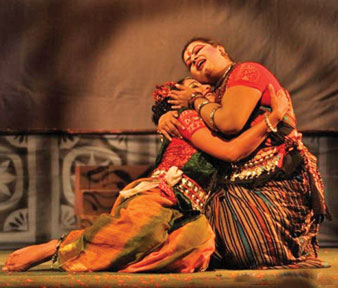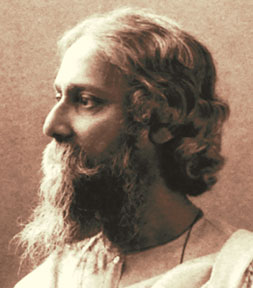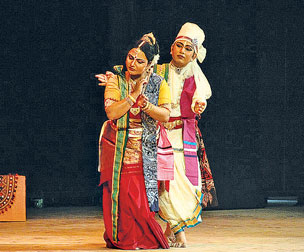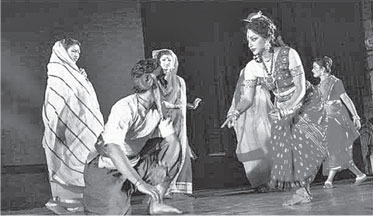Tagore, the awakening voice in Indian renaissance
BY Sivanandini DURAISWAMY
“Let me light the lamp,”
says the star.
“And never debate if it will help to remove the Darkness.”
Tagore was an Awakening Voice in the Indian Renaissance. He founded
Shanatiniketan an educational Institution known as the Abode of Peace.
Modelled on the ancient Ashrama style, Shantiniketan through the years
developed into Vishwa Bharati, a Universal Global Consciousness.
 To commemorate his one hundred and fiftieth birth anniversary, a well
known group of artistes from Vishwa Bharati is to perform the dance
dramas Sapmochan at the John R De Silva Memorial Hall on October 3 and
Chanadalika at the Ramakrishna Hall on October 4. These dance drams are
a celebration as a tribute to Tagore’s creativity in music and dance To commemorate his one hundred and fiftieth birth anniversary, a well
known group of artistes from Vishwa Bharati is to perform the dance
dramas Sapmochan at the John R De Silva Memorial Hall on October 3 and
Chanadalika at the Ramakrishna Hall on October 4. These dance drams are
a celebration as a tribute to Tagore’s creativity in music and dance
Tagore adopted the dance drama style, inspired by Indian ideas drawn
from traditional sources to express his thoughts on Universal Truths.
His admiration and deep reference to the Buddha helped him to render
various themes into sublime narratives.
The Indian society at that time was very rigid regarding dancing and
singing as the understanding of these were restricted to prostiutues and
courtesans! It was Tagore’s literary genius that introduced the concept
of dance drama as a possible tool to defy these regressive norms of
society. One is reminded here of Rukmani Devi Arundale who also had to
fight these regressive norms to bring back Bharata Natyam into society
in South India. Bharata Natyam was considered the monopoly of the Deva
Dasis, the temple dancers! Girls were not allowed to pursue a course in
dancing. To combat this, she learnt dancing herself, founded Kalakshetra
and performed on the stage.
To artistes such as Tagore and Rukmani Devi, dance and music are
purely expressions of emotions in spiritual ecstasy, sacrosanct and
universal.
Chandalika
Tagore had a lasting regard for the Buddha especially the rational
and humanistic aspects of his teachings. He was greatly inspired by the
Buddhist ideals of compassion and forgiveness.
These appealed to his creative genius and the Buddhist principle of
man’s social equality was particularly alluring to his own Hindu concept
of “Divinity in man.”
The dance drama Chandalika is a dramatic expression of this ideology
in the form of the age old struggle of the marginalised section of
Indian society wanting to be recognised and attain the status of
equality and humanism.
It is a visual presentation of conflict between marginality and
spirituality. It is purely dramatic where the theme evolves through
attractive dances, mime, delightful melodies and choreography.
He rendered the conflict of the Untouchable into a sublime narrative
by transforming it with his creative imagination, tinting it with his
own humanistic philosophy of life calling it Chandalika.
In this dance sequence, he features only three characters namely,
Prakriti, Mother and Ananda. The mother and daughter Prakriti represent
the marginalised who are in conflict with the spiritual world of Ananda.
Prakriti is a young girl anguished with her life as an untouchable
where she is denied even simple pleasures like buying bangles from the
bangle seller who refuses to sell and the flower seller who refuses to
sell flowers. Young girls wear bangles and wear flowers in their hair
but she was denied these.
In retaliation, she emerges as the voice of the silenced and
marginalised. She is a rebel who questions social norms that relegated
her to an existence of an untouchable.
 Prakriti’s mother has magical powers and once when the water dried up
in the village she was ordered to find water. However, when she finds
water, her family is not allowed to use the same water since they are
untouchables! Her magical power does not redeem them from their
suffering and humiliation. Prakriti’s mother has magical powers and once when the water dried up
in the village she was ordered to find water. However, when she finds
water, her family is not allowed to use the same water since they are
untouchables! Her magical power does not redeem them from their
suffering and humiliation.
She meets Ananda the disciple of the Buddha who comes in search of
water. “Give me water,” asks the bhikkhu to which Prakriti resists by
voicing her powerlessness to quench the bhikkhu's thirst saying “Iam a
chandalini.”
“No! you are not impure. You are the child of the same Almighty as
others,” said the bhikkhu awakening her to a moment of truth.
All this while she thought of herself as a victim of social stigma
and she was suddenly pushed into a moment of recognition.
“This is my new birth,” she tells her mother “ I am now purified by
satisfying the thirst of a bhikkhu. I am now aware of my “Self.” I know
what freedom tastes like.” She is jubilant.
The dance drama begins with the inspiring words, “Give me water,”
where the mother and daughter confront each other over the words.
Ananda addresses Prakriti as a normal human being and not as an
untouchable, Chandalini. Besides indicating his physical need, water
symbolises the regenerative image common in our religious traditions. In
the Indian context, the request for water by a bhikkhu from an
untouchable violates a social norm for at that time, it was unheard of
for a bhikkhu to ask for water or food from an untouchable.
In this request for water, Prakriti’s sense of being an outcaste is
completely negated awakening her blind subjugated mind to equality and
awakens the “Self” in her! From the bondage of untouchability a new
Prakriti is born defying all oppressive customs revolving against
society itself.
Prakriti now revolts against the society she lives in. We now see a
very possessive Prakriti, yearning for Ananada. And in this attitude of
possessiveness she commits a flaw – the desire to possess Ananda and she
steps beyond the religious and ethical boundaries.
But the bhikkhu in his pursuit of nirvana is a celibate beyond
worldly pleasures and obligations. He is greatly respected for his
celibacy and morality.
However, Prakriti to push herself further, falls in love with the
bhikkhu and wants to marry him She seeks her mother’s help to use her
magical spells and incantations to bring Ananda to her.
The mother refused to do so remembering their position as
untouchables, and said that this could be dangerous. However, Prakriti
compels her mother to use her spell.
At the beginning Ananda immersed in his inner spiritual “Self”
ignores her and continues wit his chanting and prayers.
But Prakriti later resorts to violent means saying, “If my longing
can draw him here and if that is a crime, then I will commit it, I care
nothing for the code which holds only punishment and no comfort.”
The magical spell works and affects the bhikkhu tormenting him
  He begins to change and this yearning is against the concept of
Buddhism which forbids Bhikkhus to indulge in sex and worldly pleasures.
He gets completely bogged down losing his spiritual light that gave him
a divine radiance and purity. He was now totally emaciated. He begins to change and this yearning is against the concept of
Buddhism which forbids Bhikkhus to indulge in sex and worldly pleasures.
He gets completely bogged down losing his spiritual light that gave him
a divine radiance and purity. He was now totally emaciated.
It is only when Ananda appears in this broken mutilated state that
she realises that her action was foolish and wrong. She requests her
mother to take back the spell.
Her mother does so, falls at his feet and dies surrendering and
asking him for forgiveness.
Prakriti repents and surrenders in shame. She realises that love can
never be forced or possessed through the power of magic and
incantations.
And Ananda returns chanting Buddham saranam gachchami…. The chant
reverberates through the atmosphere and gradually fades away as Ananda
retunrs to his ashram.
It is through the dance drama that the tender theme of Chandalika is
enacted. Prakriti is able to articulate her anger and love through dance
movements and expressions – anger in being pushed aside because of her
social status which is forced upon her and love for a bhikkhu who
respects and acknowledges her as a human being. She surrenders herself
and her mother dies at the bhikkhu's feet asking forgiveness.
|


